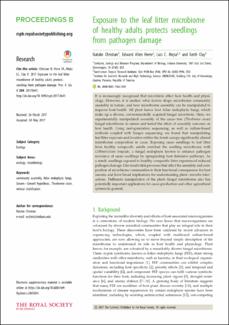Mostrar el registro sencillo del ítem
Exposure to the leaf litter microbiome of healthy adults protects seedlings from pathogen damage
| dc.contributor.author | Christian, Natalie | |
| dc.contributor.author | Herre, Edward Allen | |
| dc.contributor.author | Mejia, Luis C. | |
| dc.contributor.author | Clay, Keith | |
| dc.date.accessioned | 2020-07-09T04:01:15Z | |
| dc.date.available | 2020-07-09T04:01:15Z | |
| dc.date.issued | 2017-07-05 | |
| dc.identifier.other | http://dx.doi.org/10.1098/rspb.2017.0641 | |
| dc.identifier.uri | http://repositorio-indicasat.org.pa/handle/123456789/188 | |
| dc.description | It is increasingly recognized that microbiota affect host health and physiology. However, it is unclear what factors shape microbiome community assembly in nature, and how microbiome assembly can be manipulated to improve host health. All plant leaves host foliar endophytic fungi, which make up a diverse, environmentally acquired fungal microbiota. Here, we experimentally manipulated assembly of the cacao tree (Theobroma cacao) fungal microbiome in nature and tested the effect of assembly outcome on host health. Using next-generation sequencing, as well as culture-based methods coupled with Sanger sequencing, we found that manipulating leaf litter exposure and location within the forest canopy significantly altered microbiome composition in cacao. Exposing cacao seedlings to leaf litter from healthy conspecific adults enriched the seedling microbiome with Colletotrichum tropicale, a fungal endophyte known to enhance pathogen resistance of cacao seedlings by upregulating host defensive pathways. As a result, seedlings exposed to healthy conspecific litter experienced reduced pathogen damage. Our results link processes that affect the assembly and composition of microbiome communities to their functional consequences for host success, and have broad implications for understanding plant–microbe interactions. Deliberate manipulation of the plant– fungal microbiome also has potentially important applications for cacao production and other agricultural systems in general | en_US |
| dc.description.abstract | It is increasingly recognized that microbiota affect host health and physiology. However, it is unclear what factors shape microbiome community assembly in nature, and how microbiome assembly can be manipulated to improve host health. All plant leaves host foliar endophytic fungi, which make up a diverse, environmentally acquired fungal microbiota. Here, we experimentally manipulated assembly of the cacao tree (Theobroma cacao) fungal microbiome in nature and tested the effect of assembly outcome on host health. Using next-generation sequencing, as well as culture-based methods coupled with Sanger sequencing, we found that manipulating leaf litter exposure and location within the forest canopy significantly altered microbiome composition in cacao. Exposing cacao seedlings to leaf litter from healthy conspecific adults enriched the seedling microbiome with Colletotrichum tropicale, a fungal endophyte known to enhance pathogen resistance of cacao seedlings by upregulating host defensive pathways. As a result, seedlings exposed to healthy conspecific litter experienced reduced pathogen damage. Our results link processes that affect the assembly and composition of microbiome communities to their functional consequences for host success, and have broad implications for understanding plant–microbe interactions. Deliberate manipulation of the plant– fungal microbiome also has potentially important applications for cacao production and other agricultural systems in general | en_US |
| dc.format | application/pdf | |
| dc.language.iso | eng | en_US |
| dc.rights | Info:eu-repo/semantics/openAccess | |
| dc.rights | https://creativecommons.org/licenses/by/4.0/ | |
| dc.subject | community assembly | en_US |
| dc.subject | foliar endophytic fungi | en_US |
| dc.subject | Janzen – Connell hypothesis | en_US |
| dc.subject | Theobroma cacao | en_US |
| dc.subject | vertical stratification | en_US |
| dc.title | Exposure to the leaf litter microbiome of healthy adults protects seedlings from pathogen damage | en_US |
| dc.type | info:eu-repo/semantics/article | en_US |
| dc.type | Info:eu-repo/semantics/publishedversion |

